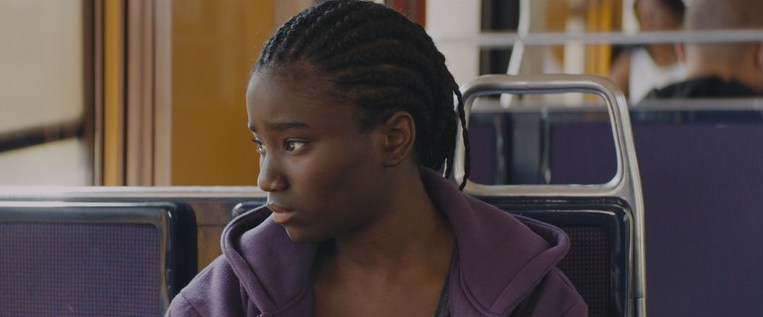Despite the American title that will inevitably provoke a rebranding effort as an ostensive companion to Richard Linklater’s recent Boyhood (2014), Céline Sciamma’s Girlhood [Bande de filles] is a defiantly singular work set in a predominantly black banlieue (suburb) of Paris, the same lower-class locale as Mathieu Kassovitz’s award-winning La Haine (1995). Sixteen-year-old Marieme (Karidja Touré) navigates the topography through a series of identity crises prompted by her failing out of school. With few options and outlets, she clings to a punkish all-female crew- Fily, Adiatou, and Lady (Mariétou Touré, Lindsay Karamoh, and Assa Sylla, respectively)- who foster a certain confidence and spontaneity from the turbulence and abuse that plagues Marieme’s home life.
Initially, there may be a substantive lack of context to her academic and parental circumstances, but the film’s depictions of these narratives are intriguingly guided by Marieme’s own reticence to confront them. Coerced by the character’s emotional urgency and the individuality of her leading actress, director Sciamma refutes overly expository clichés and a pitiable tone with eloquently evocative images, effectively sewing rhythmic hyperreality into her own distinctive fabric of social realism.
As Marieme, Karidja Touré steadily matures as one of recent cinema’s most memorable women, equally daring and chameleonic. Even in defeated moments, Marieme refuses to let herself be marked as a victim, adopting a new handle, Vic (as in “Victory”), to reflect this inner determination. Resistant to exploitation in the increasingly provocative and dangerous scenarios she is forced into, or, in some instances, has instigated herself, Marieme resiliently stands as a three-dimensional individual comparable to recent indie film heroines like Isabelle in Young and Beautiful (WFF 2014) or Jackie in The Unspeakable Act (WFF 2013). But this can be traced to Sciamma’s unique attitude and vision for the character, an extension of her own psyche. Maybe most exemplary of the director’s respect can be found in the interactions between Marieme and love interest Ismaël (Idrissa Diabaté). Their scenes possess an organic tenderness and honesty realized in both dialogue and camera framing.

Despite Girlhood‘s shifting tone into the literally and metaphorically darker territories, the empathetic direction ultimately binds the film’s fragmentary nature. The chapters in Marieme’s experiences are unofficially marked with slow fade-outs and a shimmering ambient theme (counterpoint to Steve Reich), “Néon” by Para One, that hints at emotional consummation no matter how untethered the film may feel at a given moment. (Accompanying said music is a subtly intermittent Tati-like commentary on the architecturally and technologically oppressive environment). While occurring in a short unspecified time frame, the film distills what feels like a decade’s worth of revelations and emotional maturation into an approximate year; the one apt comparison to Boyhood becomes the tracking of the wonderfully naturalistic first-time actress Karidja Touré’s transformations through wildly different hair: from tomboyish cornrows to long, straightly pressed or braided extensions.
Writer Leah Pickett touches upon a disturbing theme about the heavy internalization of girls’ formative years, which is often misrepresented on film as a direct parallel to boys’. This revelation would seemingly turn this coming-of-age tale into a more harrowing and morally didactic experience, but Girlhood resists easy scrutiny and pigeonholing on its own anomalous course. Its self-possessed camaraderie is most audaciously observed in the dreamy blue-lit hotel room sequence of the crew exultantly dancing and lip-syncing to the entirety of Rihanna’s “Diamonds,” claiming the beauty of the lyrics in their own image in the face of cultural marginalization. (Afterwards, dare to try to separate the earworm, written by Sia, from the film itself).
Above all, the film balances a suspended playfulness in an intimate and meaningful characterization. Marieme strips away all distractions and every nay-saying voice to make decisions on her own terms. In addition to the compelling lead performance, Girlhood should be celebrated for its conscientiousness and unwillingness to preach to the audience. Unlike the aforementioned Young and Beautiful‘s subversive gaze that is thematically complicated in its message, Girlhood is a convincingly feminist artistic statement because it was conceived by the collective experiences of women of different races and socioeconomic backgrounds, one of whom is in the director’s chair.
- Girlhood screens twice during the Wisconsin Film Festival 2015 as part of the “Films de Femmes: Emerging French Women Directors” series: at the Union South Marquee on Friday, Apr 10 (7:00p), and at Sundance Cinema 6 on Sunday, Apr 12 (11:00a). Rush tickets are only available for both showtimes.
- Additionally, as part of World Cinema Day for high school students on Apr 9, the film is screening at the Marquee (9:30a, 12:45p).

1 Comment